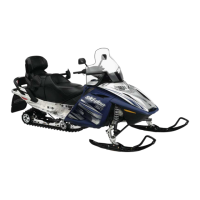Stoppin g
Before riding your snowmobile, you should under stand how to stop
it. This is done by releasing the throttle and gradually depressing
the brake lever on the left side of the handlebar. In an emergency,
you may stop your vehicle by pressing the engine cut-out switch
located near the thrott le control and applying the brake. Remember,
a snowmobile c annot “stop on a dime”. Braking characteristics vary
with deep snow, packed snow or ice. If the track is locked during
hard braking, skidding may result.
How to Ride
How to Dress
Proper snowmobile clothing should be worn. It should be com fort-
able and not too tight. Alw ays check the weather forecast before
going on a ride. Dress for the coldest weather expected. Thermal
underwear next to the skin also provides a good insulation.
DOT approved helmets are recommended at all times. They provide
both warmth and reduce injury. A stocking type cap, balaclava and
face mask should always be carried or worn. Goggles or a face shield
th at attach to the hel met are i ndispens abl e.
Hands should be pr otected by a pair of snowmobile gloves or mitts
which have sufficient insulation and allow use of thumbs and fingers
fo r operatio n of controls.
Rubber bo ttom b oots wi th e ith er a n ylo n o r a le ather top, w ith re-
movable felt liners are best suited for snowmobiling.
You should keep your self as dry as possible when snowmobiling.
W hen you com e indoor s, take y our snowmobile suit and boots off
and make c ertain they dry prop erly.
Do not wear long scarfs and loose apparels t hat could get caught in
moving par ts.
What to B ring
Every snowm obiler should carry at least the following basi c parts and
tools that can help him and others in an emergency:
• th is Operator's G ui de
• spare spark p lugs and wrench
• friction tape
• spare drive belt
• spare s tarter rope
• spar e light bulbs
18
_____
SAFETY INFORMATION
_____

